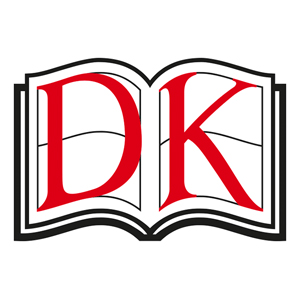Title of the work
Country of the First Edition
Country/countries of popularity
Original Language
First Edition Date
First Edition Details
DK, The Mythology Book: Big Ideas Simply Explained. Penguin Random House, 2018, 352 pp.
ISBN
Genre
Encyclopedias
Target Audience
Young adults
Cover

We are still trying to obtain permission for posting the original cover.
Author of the Entry:
Ayelet Peer, Bar-Ilan University, ayelet.peer@gmail.com
Peer-reviewer of the Entry:
Lisa Maurice, Bar-Ilan University, lisa.maurice@biu.ac.il
Elżbieta Olechowska, University of Warsaw, elzbieta.olechowska@gmail.com

The DK logo for web use, 2014. Retrieved from Wikimedia Commons, licensed under CC BY-SA 4.0 (accessed: January 11, 2022).
DK
, b. 1974
(Company)
DK is a publishing house which was founded in London in 1974. The offices of DK are located around the world. They offer books on various themes, from children’s books to gardening and education. DK is currently “the world leading illustrated reference publisher and a member of the Penguin Random House division of Bertelsmann." (Cited from here and here, accessed: August 11, 2020).
There are several academic contributors to this volume (for all the mythologies narrated): Philip Wilkinson (the consultant), Georgie Carrol, Dr. Mark Faulkner, Dr. Jacob F. Field, Dr. John Haywood, Michael Kerrigan, Neil Philip, Dr. Nicholaus Pumphrey, Juliette Tocino-Smith.
Source:
Official website (accessed: August 11, 2020).
Prepared by Ayelet Peer, Bar-Ilan University, ayelet.peer@gmail.com
Summary
The book presents eighty references from world mythology. The text is accompanied by graphics and photos. The mythologies included in the book are ancient Greek, ancient Roman, Northern Europe, Asia, The Americas, Ancient Egypt and Africa, and Oceania. The book includes a directory and index.
Before the actual myth, a short introduction to the relevant culture is given,, as well as an “in brief" section, a short table which contains the theme of the myth, its ancient sources, the setting and key figures as well as a relevant citation or a short title above the table. For example, in the Origin of Humanity theme, the citation is “He bound cunning Prometheus in Inescapable Fetters; Prometheus Helps Mankind”. Then we have the sources: “Theogony and Works and Days, Hesiod, c. 700 BCE; Library, Apollodorus, c. 100 CE”; the setting: “Greece, the Aegean, and the Caucasus Mountains, Western Asia” and the key figures with a sentence of explanation: Zeus King of the gods and then Iapetus, Klymene, Prometheus, Deukalion, Pyrrha, Hephaistos.
The myths are taken from various sources, from epic to tragedy, to Xenophon’s anabasis. It appears that the authors tried to present a varied assembly of myth, from creation myths to the Trojan war and to metamorphoses and even include the myth of Atlantis.
The episodes of Greek myths briefly introduced in this book are:
- Creation by Mother Earth;
- Origin of the Olympian Gods;
- Titanomachy;
- Mt. Olympus;
- Origin of Humanity;
- Pandora’s box;
- Zeus’ love affairs;
- The underworld;
- The abduction of Persephone;
- Dionysus and the Maenads;
- Orpheus and Eurydice;
- Hermes’ exploits;
- Athena and Poseidon’s contest;
- Myths relating to Apollo’s prophecy;
- Apollo and Daphne;
- Abduction of Helen;
- Oresteia;
- Odyssey;
- The Labours of Herakles;
- Theseus and the Minotaur;
- Daedalus and Icarus;
- Perseus and Medusa;
- Medea and Jason;
- King Oedipus;
- Aphrodite and Adonis;
- Midas’ Golden Touch;
- Atlantis.
The myths pertaining to ancient Rome are:
- Aeneas’ travels;
- Romulus and Remus;
- Jupiter and king Numa;
- Vesta;
- The Sybil of Cumae;
- Cupid and Psyche;
- Narcissus;
- Arachne;
- Atalanta and Hippomenes;
- Mithras;
- Pygmalion and the Statue;
- Philemon and Baucis.
Analysis
The ambitious aim of this book is to provide the readers with a taste of the vast span of world mythology, hence the myths included are only briefly related. The references to sexual acts make the book unsuitable for younger children. For example, it is written that “just as Ouranos had dominated Gaia, Kronos required his wife and sister Rhea to be exclusively and endlessly available to him in order to meet his sexual needs.” (Location 320). This citation also demonstrates how the authors include their value judgment in the stories. Some myths in which rather more mature themes are prominent, such as the Oresteia, are also included. Therefore older readers may understand this narrative better.
Under Roman Mythology, the authors choose to narrate tales form the Aeneid and Cupid and Psyche, but also included myths found in Ovid’s Metamorphoses (although Greek in origin), such as the story of Narcissus and Echo, Arachne and Minerva and even Philemon and Baucis. They also incorporate stories on Cybele and Mithras, even though they were not originally Roman deities, but Eastern. The Romans indeed incorporated into their pantheon foreign gods and allowed their cults in Rome. With regard to the Cybele, it is stated that “The ancient Greeks saw the goddess Cybele as the mother of the gods and of mankind. She first appeared in Phrygia, now part of west-central Turkey. The Greeks associated her with the mother goddess Rhea, as did the Romans, who made Cybele the centre of a popular cult from the 4th century BCE onwards.” (location 2120). Hence she is hardly a Roman deity, although she is connected with Aeneas in some stories. The reasons for this is probably that, apart from the Aeneas and Romulus & Remus, there is very little uniquely Roman in the mythology received in the Western culture. Even Roman mythology of the metamorphoses is essentially Greek, and by attributing these myths in this way, the book perpetuates an inaccurate image of Roman mythology.
Addenda
The review refers to the Kindle edition.


